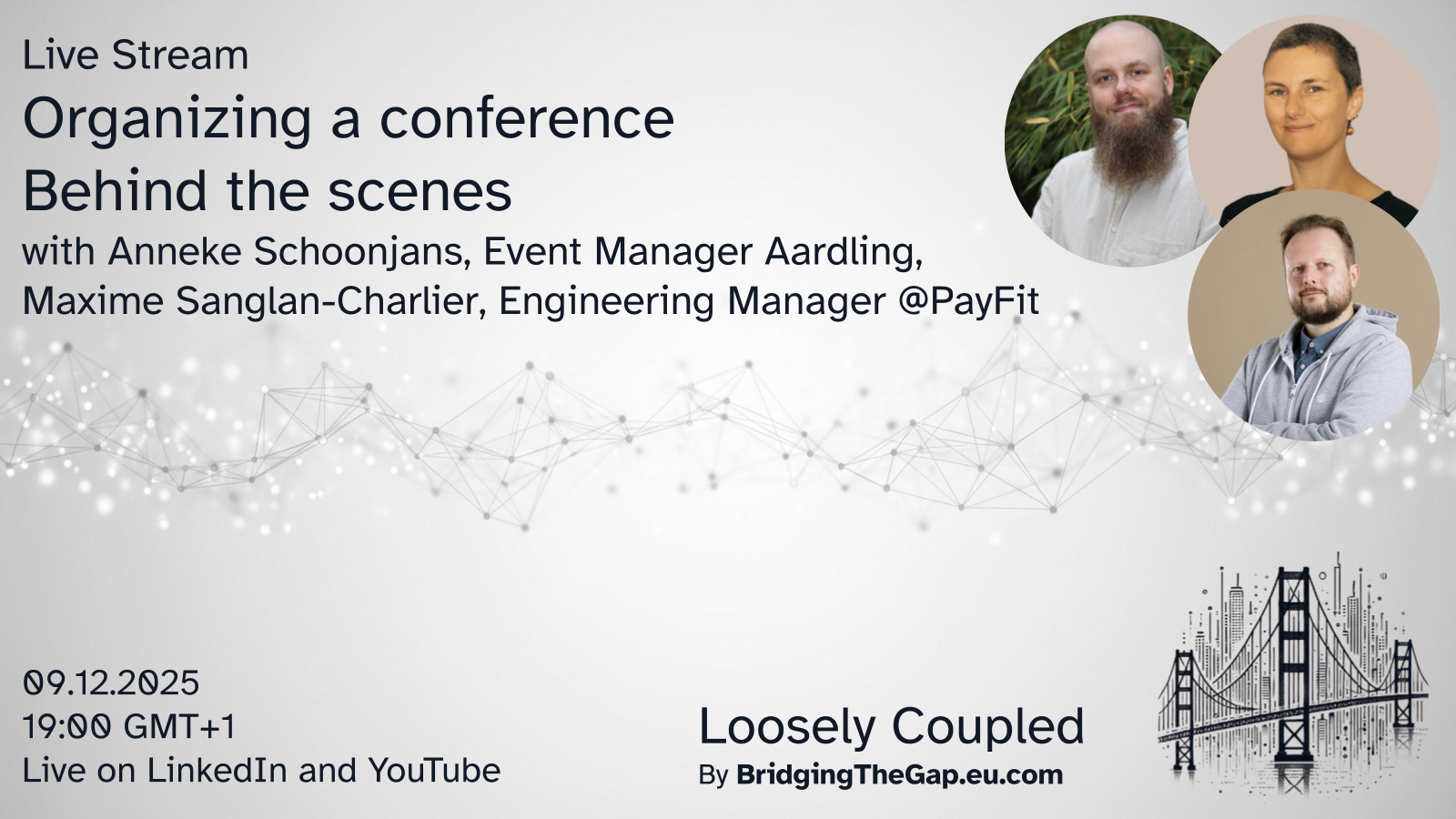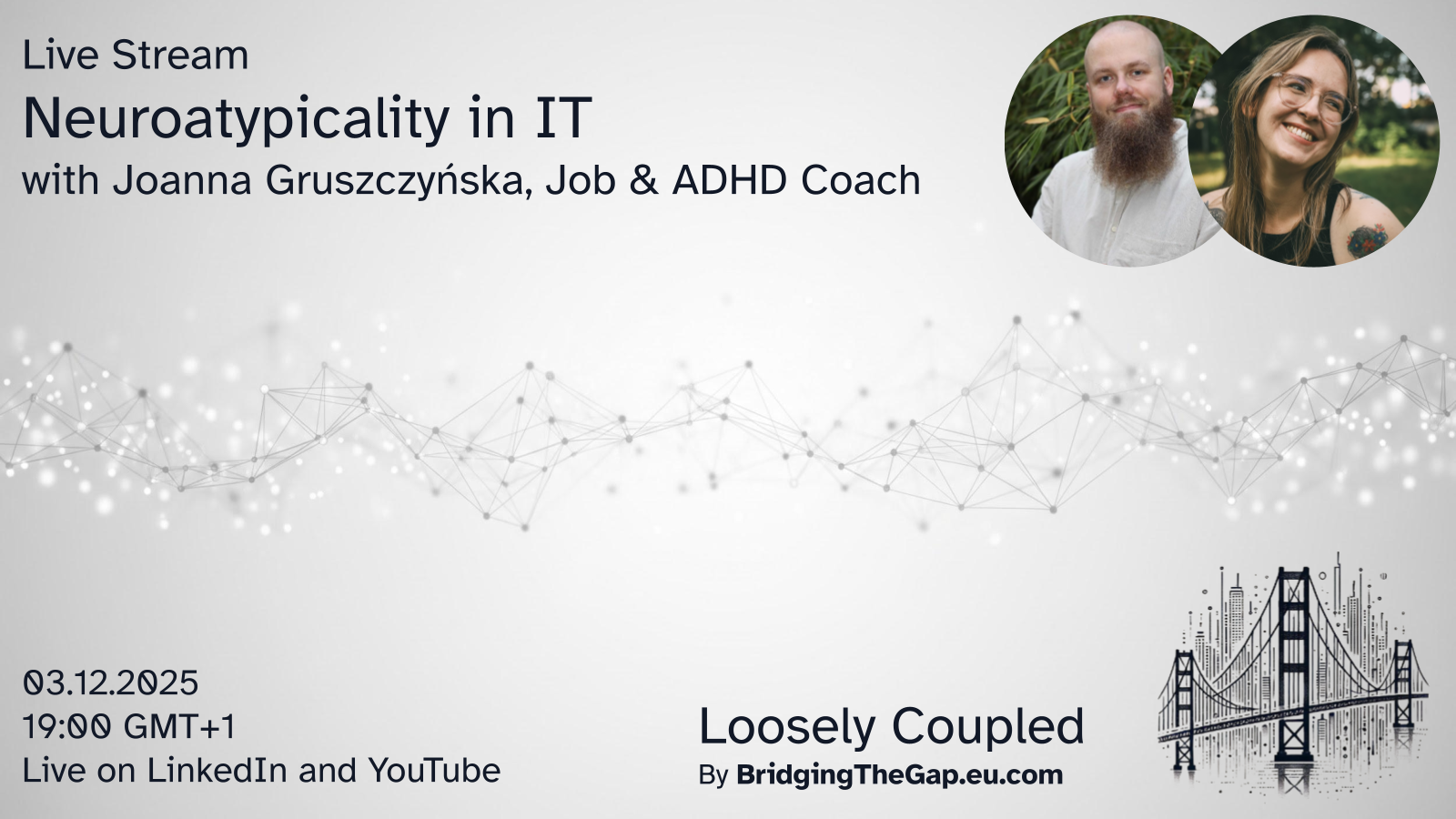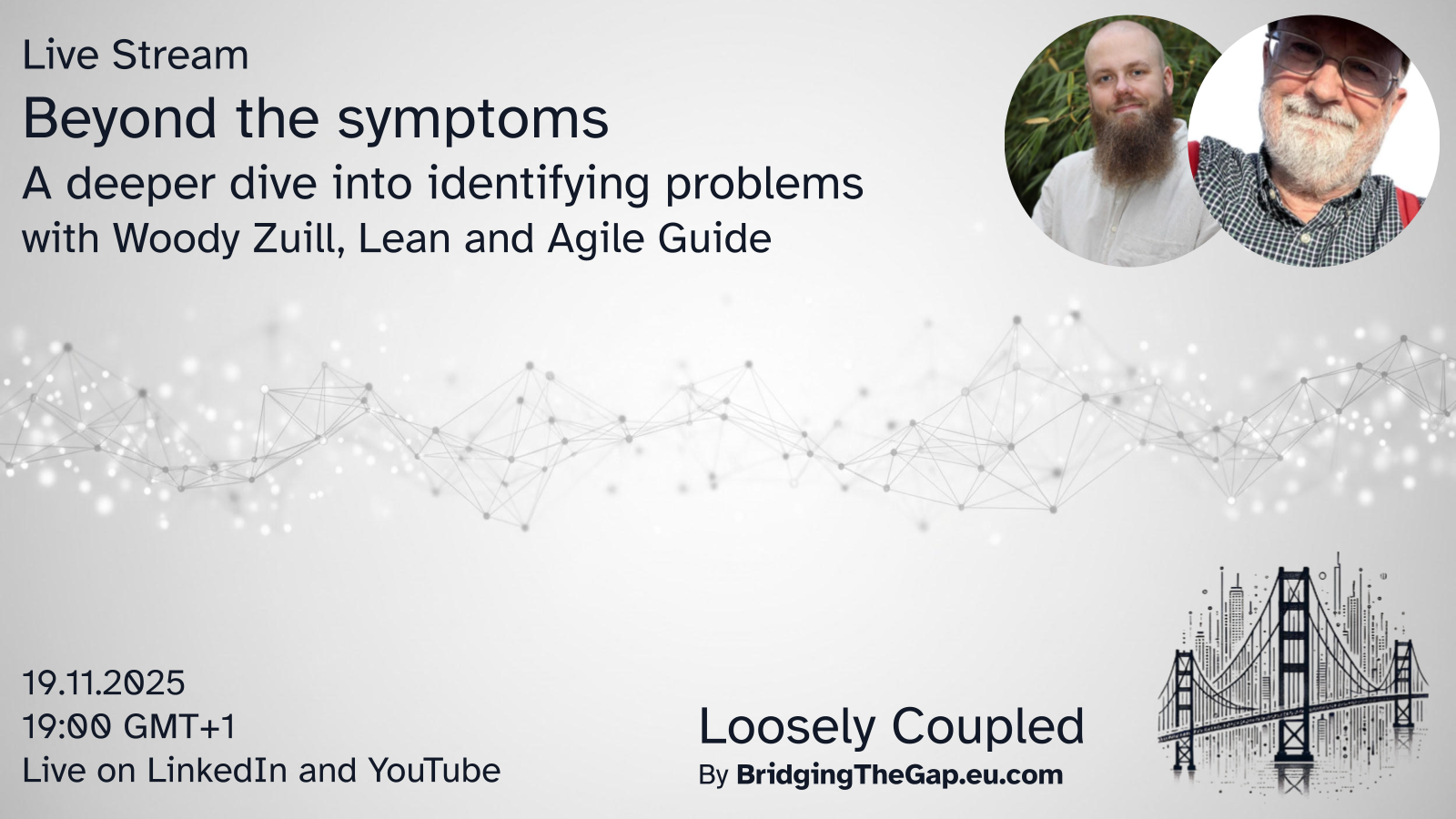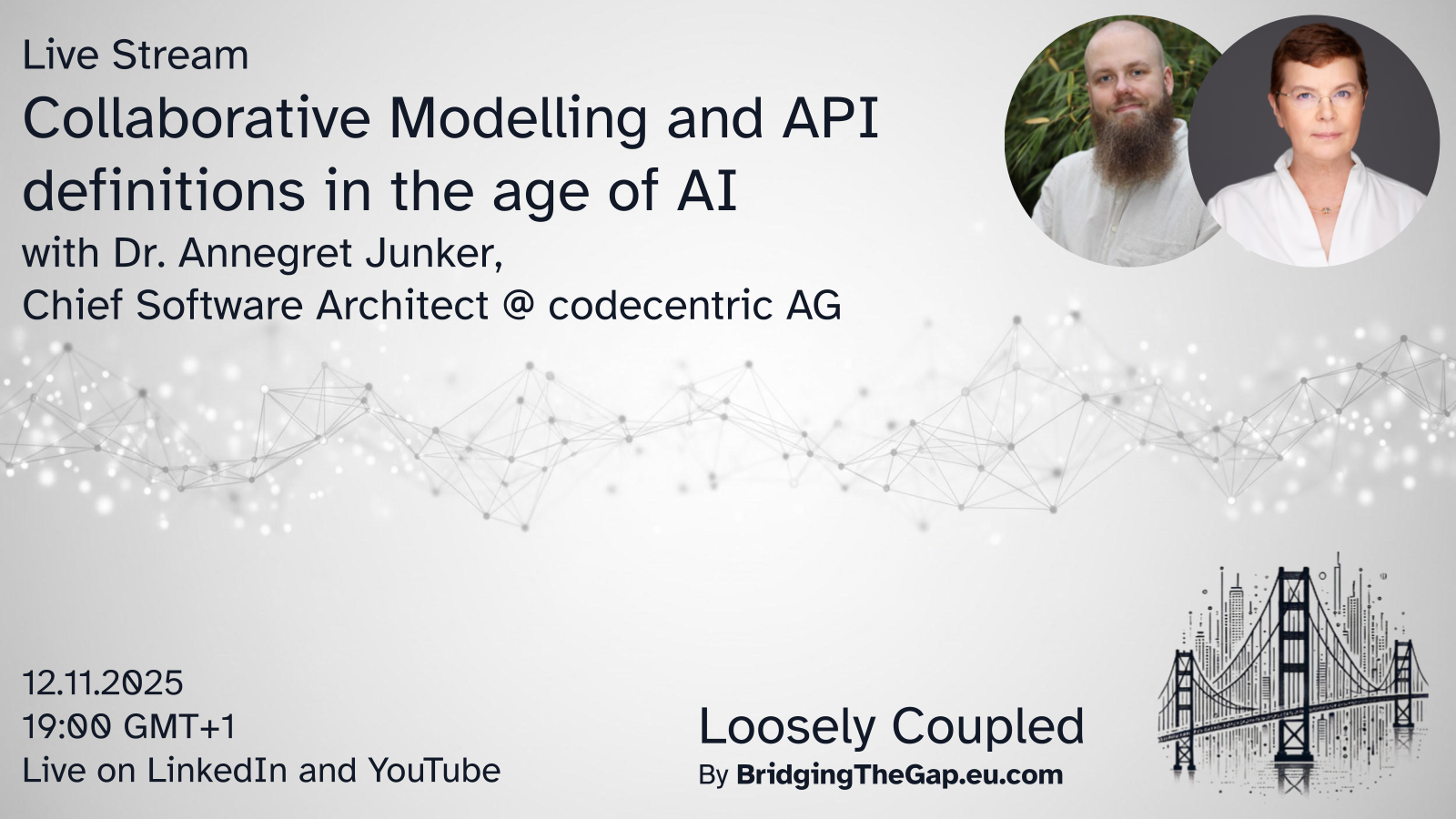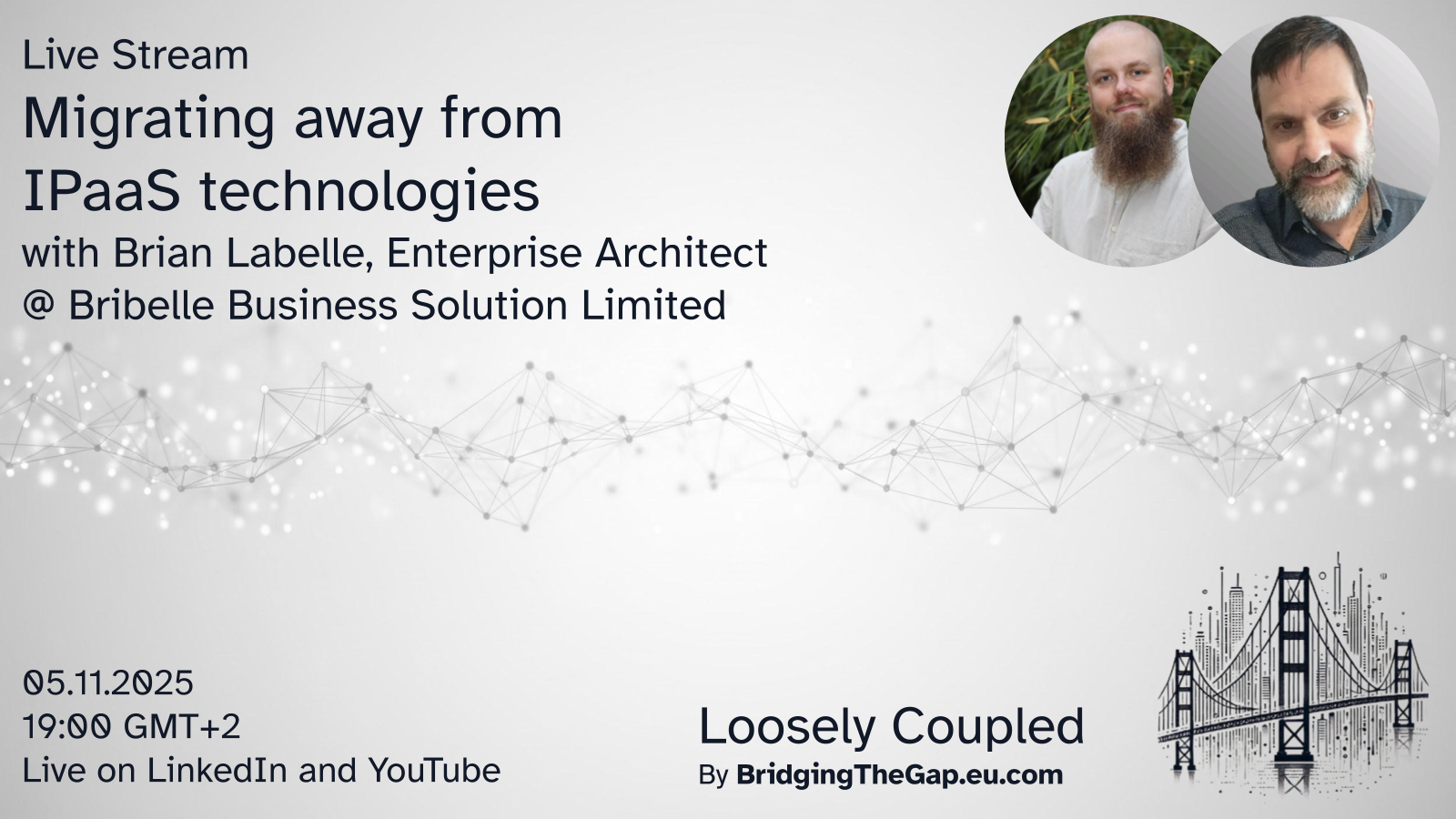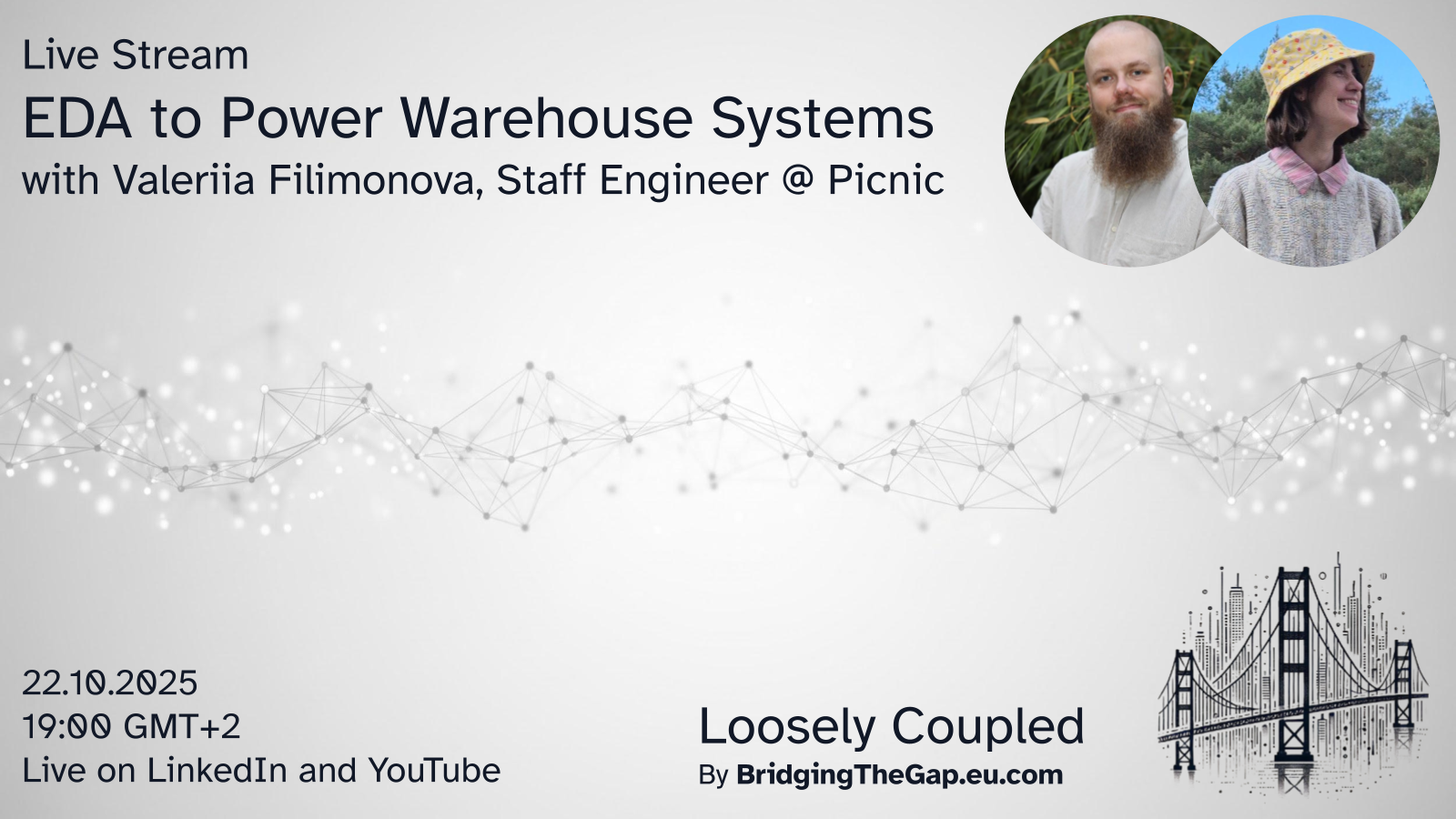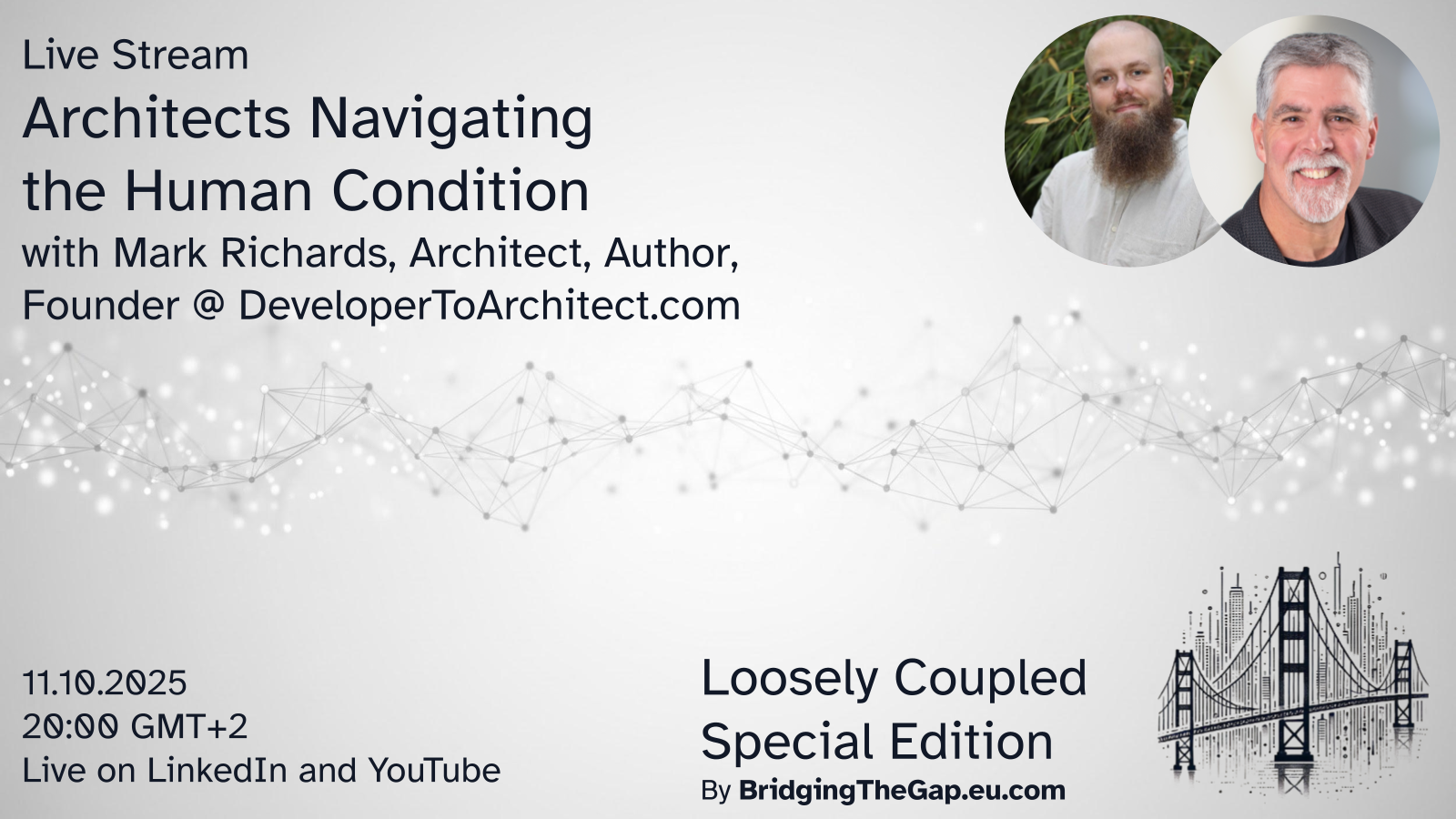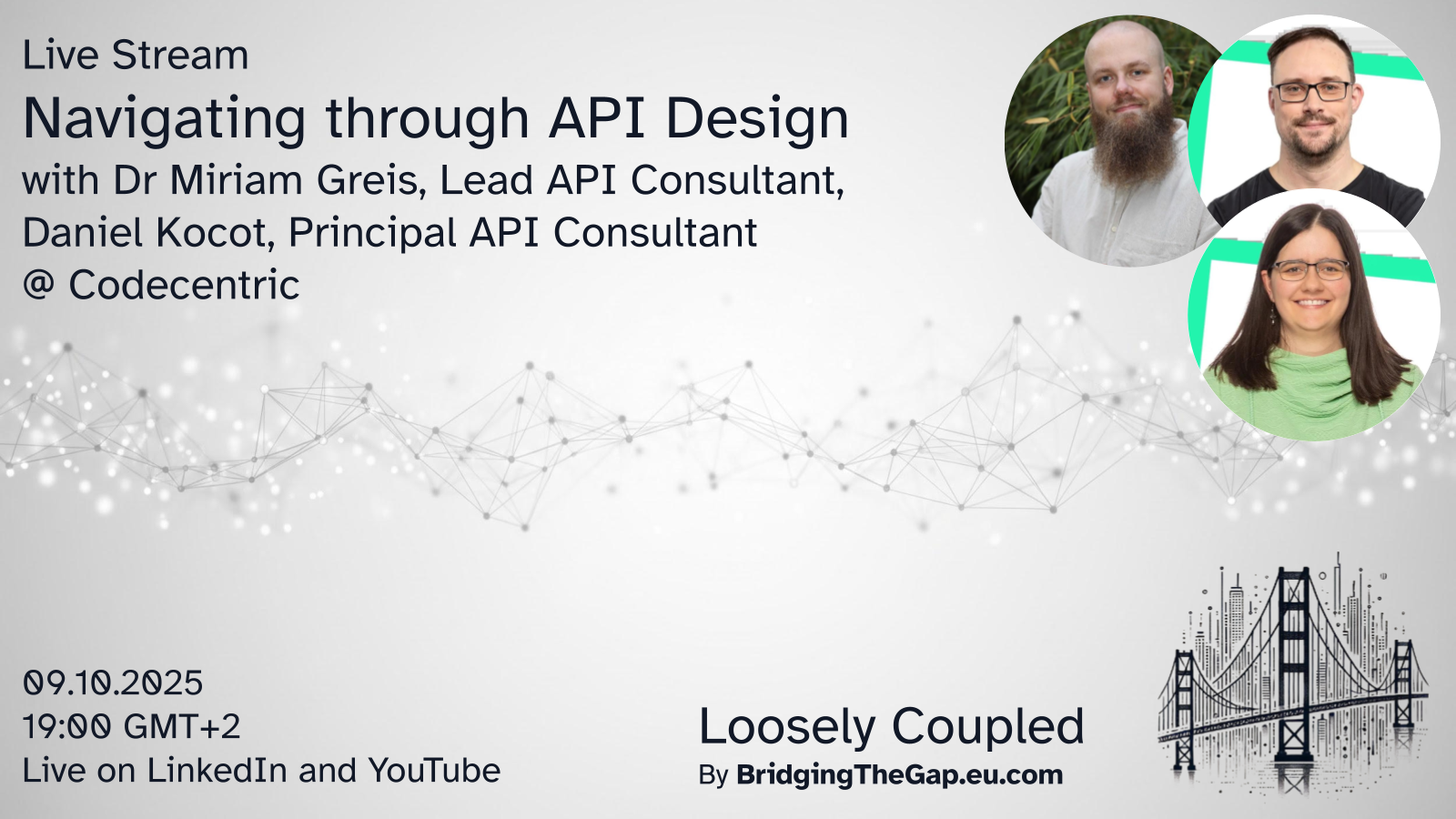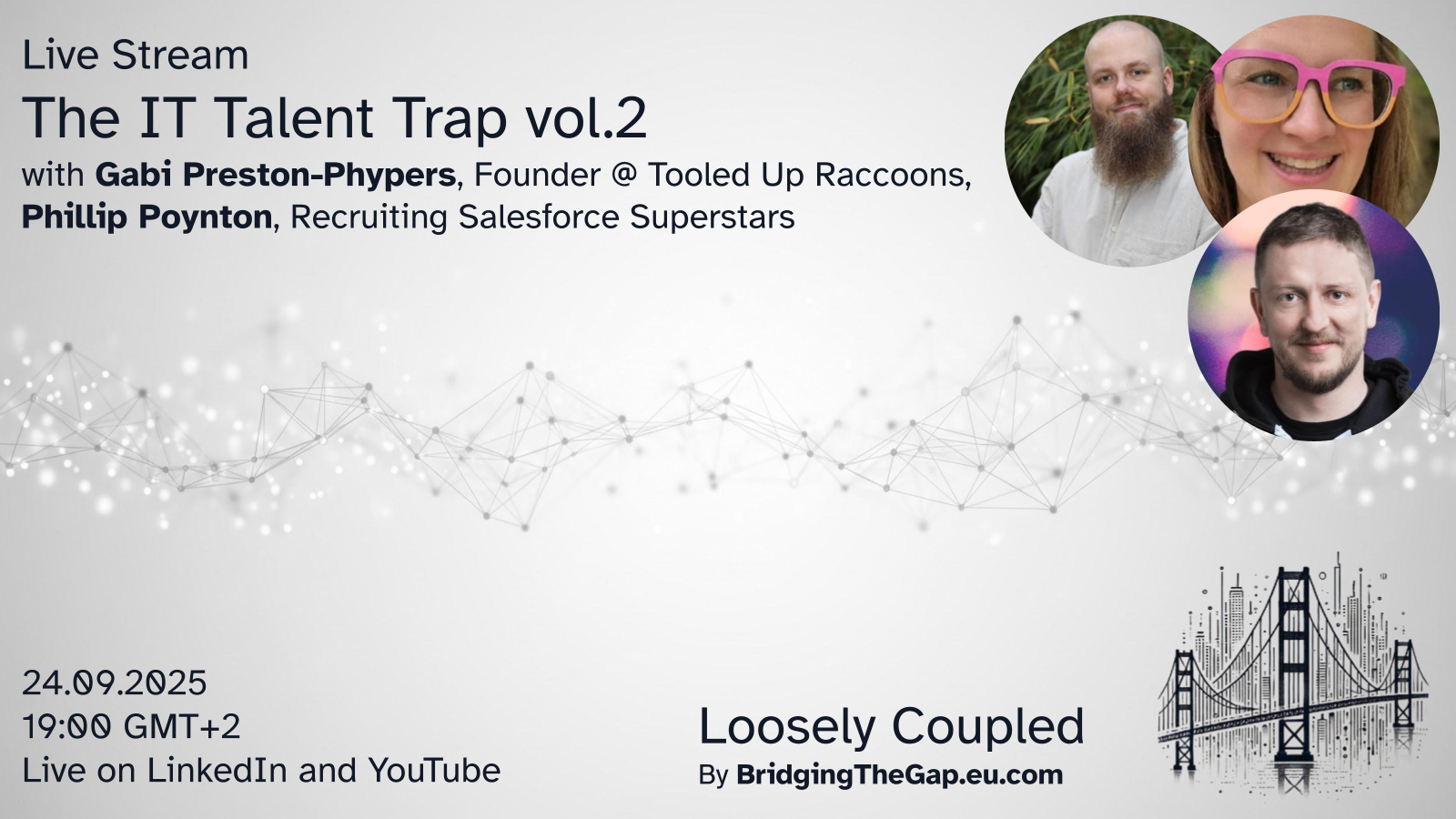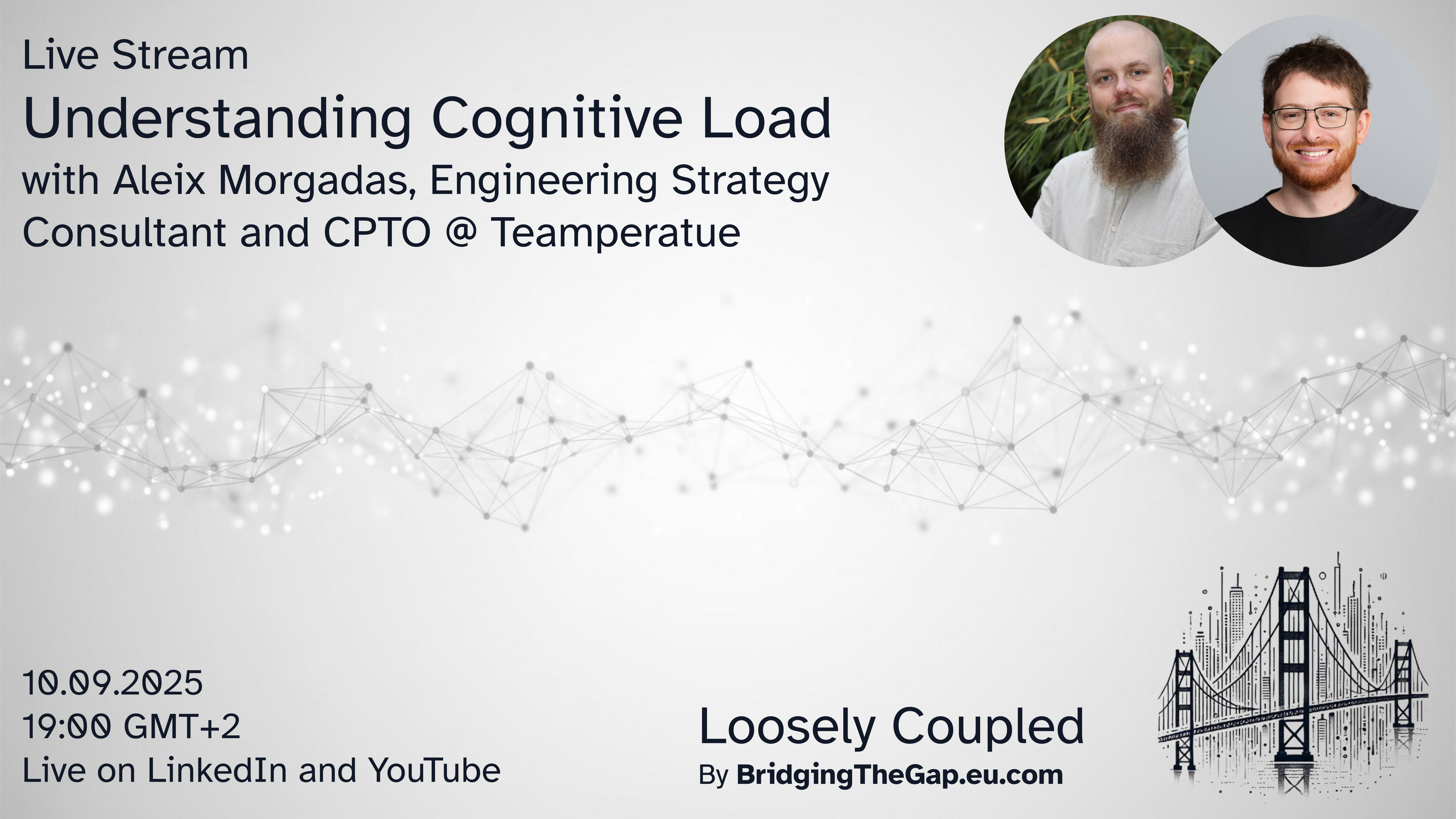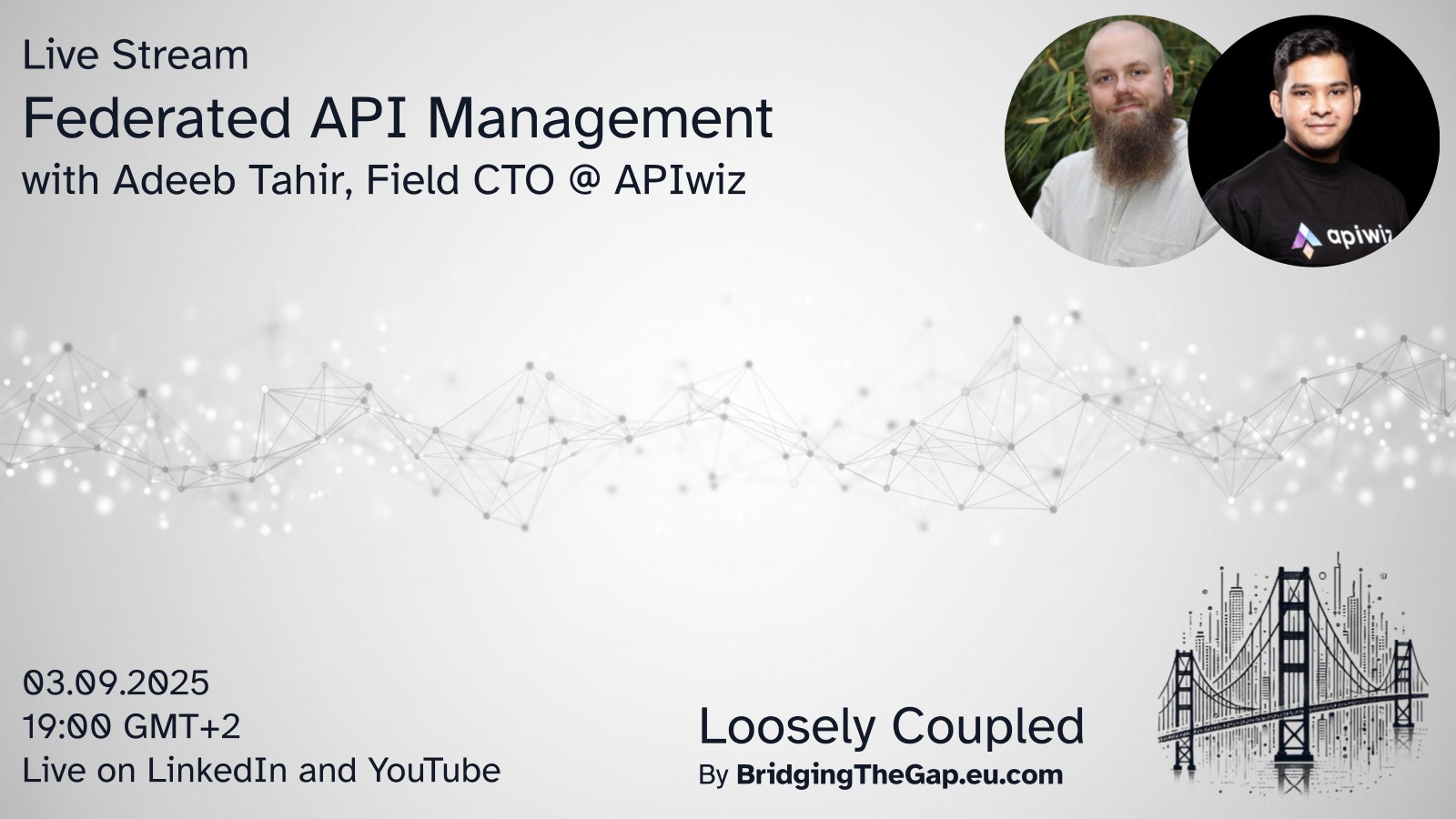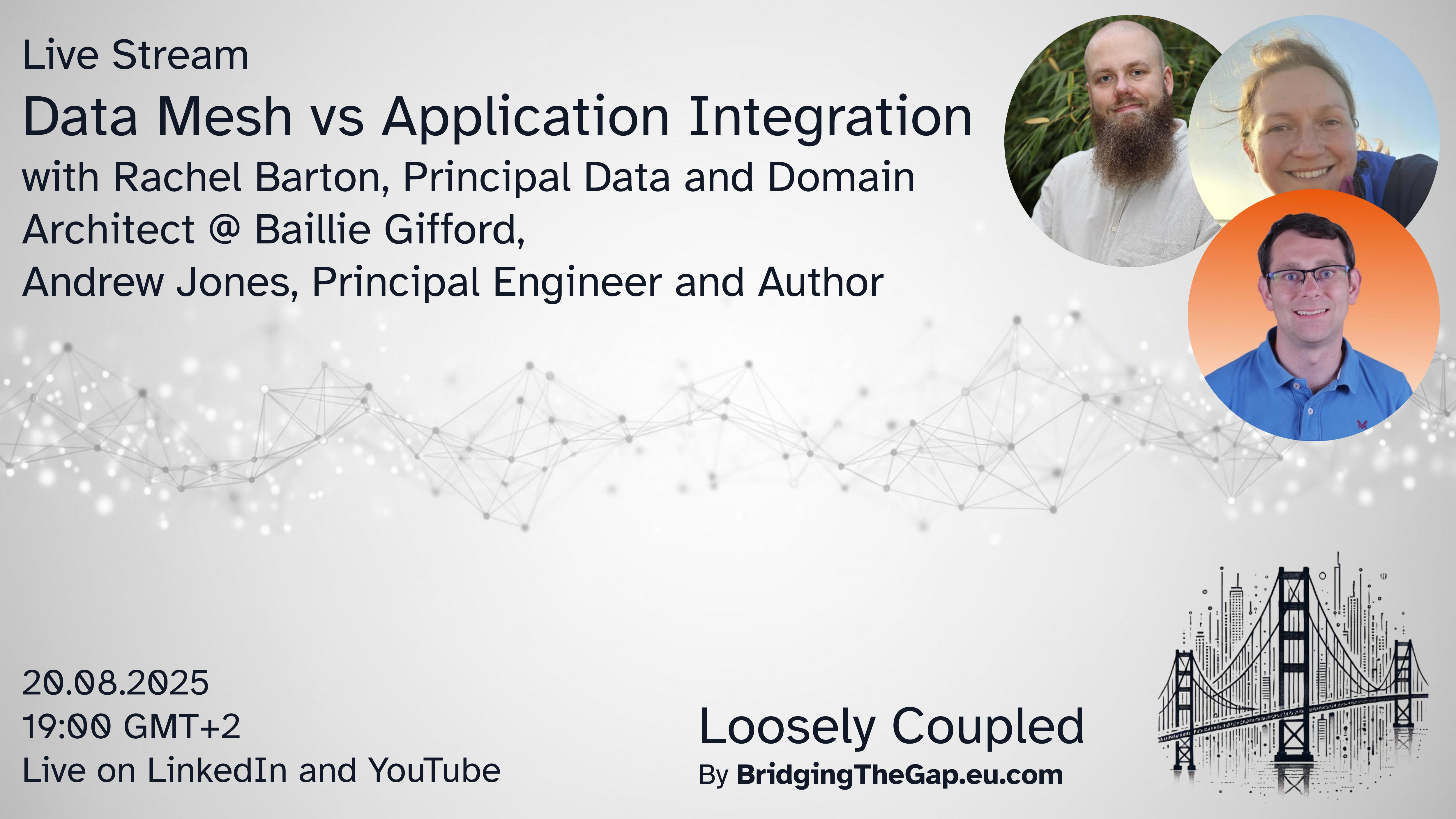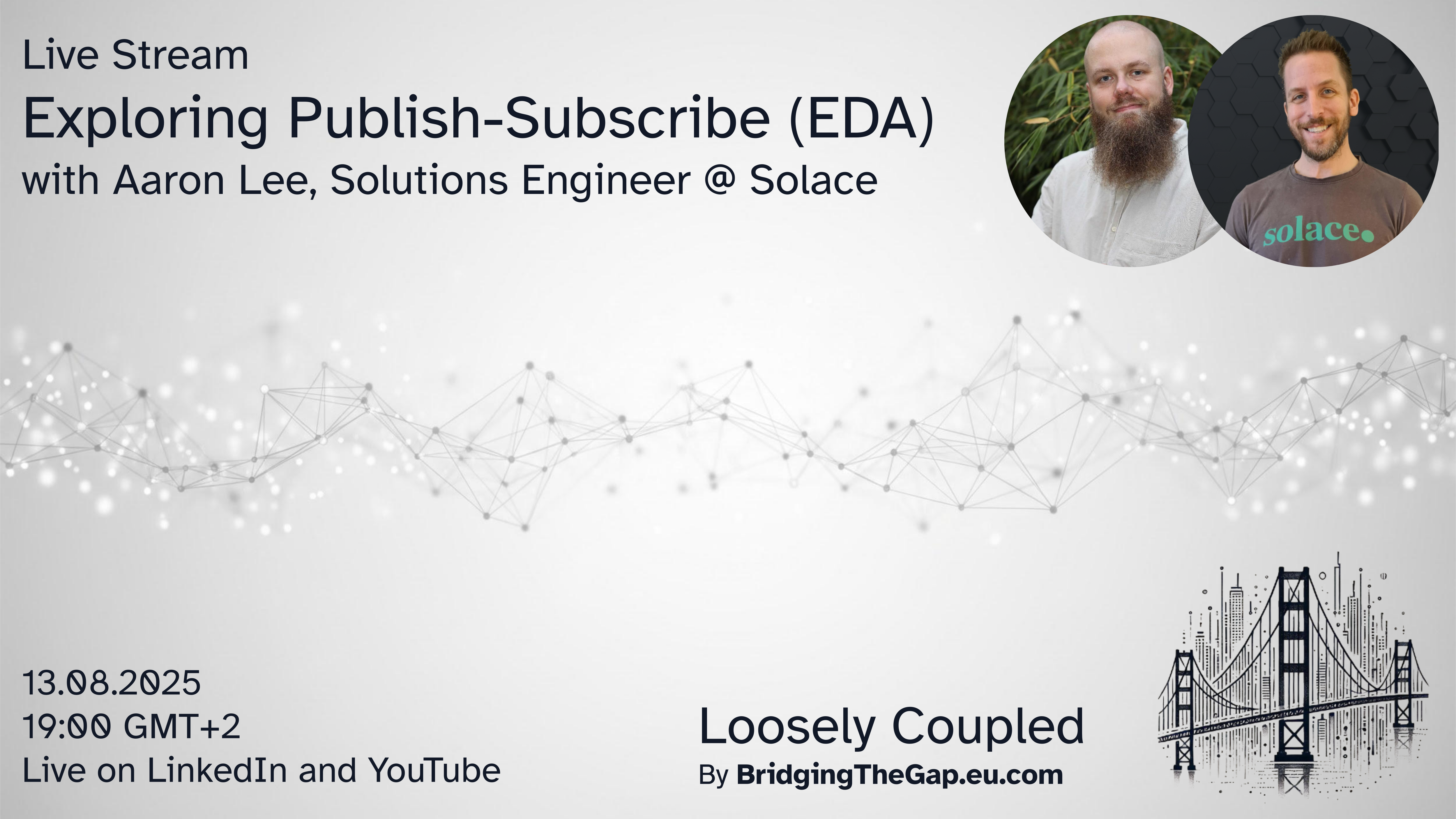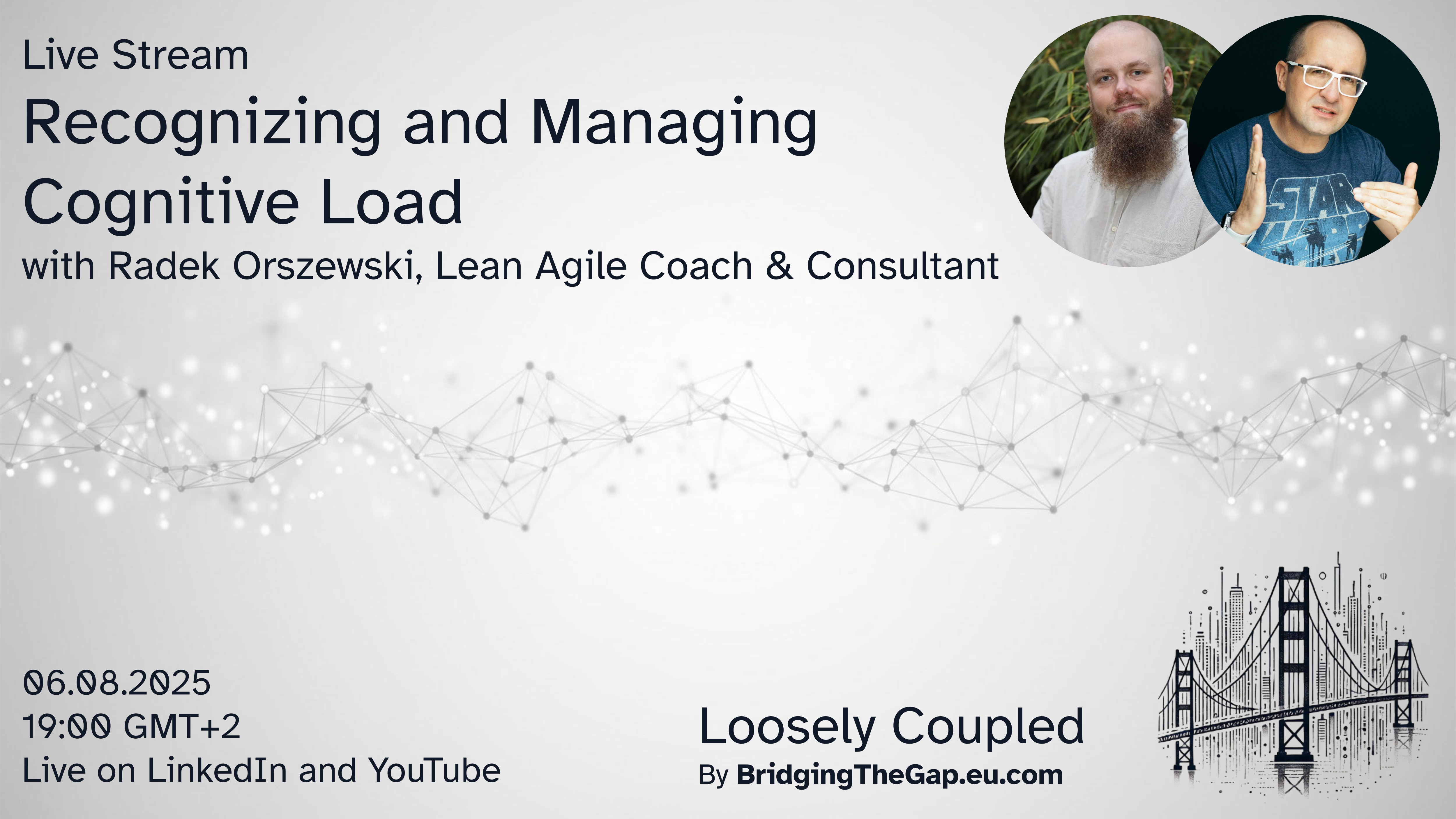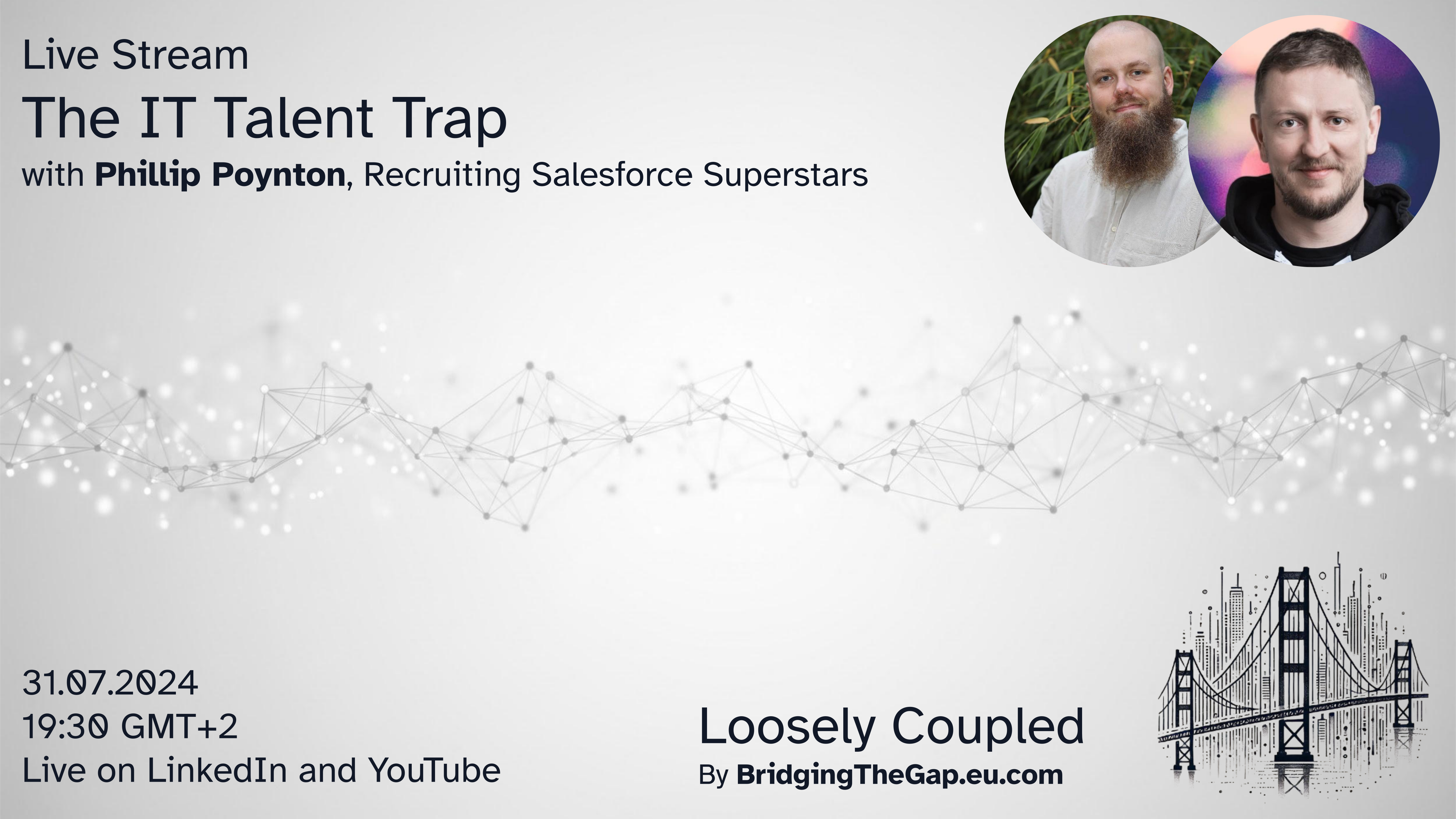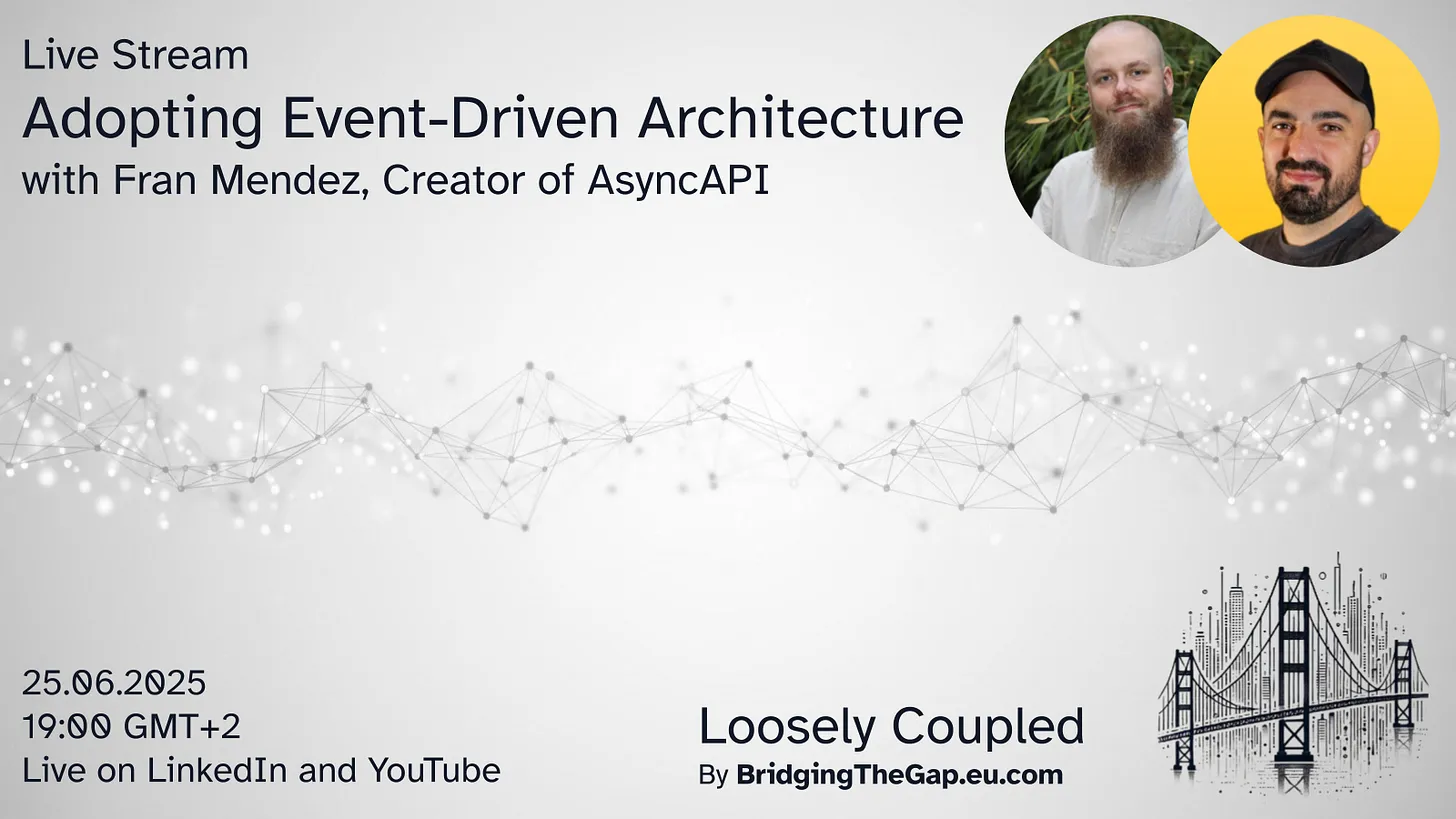All
Articles
Streams
Show Hidden Tags (-3)
Showing 41 of 41 articles/events
Looking for upcoming events?
View Events Calendar
Strategic Integration Design with DDD
1/19/2026
Most integration landscapes grow messy, siloed, and become hard to change. This course shows you how to design interoperability with purpose. Apply Domain-Driven Design to integrate architecture so your systems work together, scale with your organization, and stay aligned to your business needs.
Organisations often reinvent the wheel when connecting systems. Custom point-to-point solutions emerge, silos deepen, and technical decisions drift away from business intent. This results in unwanted complexity that slows delivery and limits agility.
Strategic Integration Design with DDD equips your team to turn integration into a strategic capability. By combining collaborative modelling with proven integration patterns, you will learn how to design flows that serve business goals, create reusable assets instead of one-off fixes, and evaluate when larger transformation steps are needed. Along the way, you will see how interoperability follows organizational structure (Conway’s Law in action) and how reducing different kinds of coupling leads to systems that can evolve with the business.
Participants value this course because it gives names and theories for practices they already use informally, demystifies industry jargon and introduces practical tools for comparing trade-offs.
For who?
• Solution & Integration Architects,
• Staff/Principal Engineers,
• Engineering Managers, Directors, and Business Analysts, Consultants.
Learning outcomes
What You’ll Learn
• Elicit integration requirements with EventStorming: Quickly map business processes, events, and bounded contexts to uncover where systems must interoperate.
• Depict flows with Domain Message Flow: Visualize how events, commands, and queries travel across systems, and match them to well established integration patterns.
• Apply trade-off analysis: Use a structured tool to weigh integration options and choose with confidence.
• Recognize maturity stages: Understand the complexities of Enterprise Application Integration (EAI), and that they are not binary choices.
• Reduce coupling: Identify different types of coupling, and learn how to balance them.
• Demystify architecture styles: Place different approaches in context, clarifying what they solve and where their limits are.
• Plan integrations purposefully: Design reusable solutions directly aligned with business needs, rather than ad-hoc fixes.
Why Attend?
• Strategic clarity: Understand which integration approaches fit your context and how to explain trade-offs to stakeholders.
• Shared language: Give teams a vocabulary to describe integration patterns and styles, reducing confusion and reliance on constantly misused buzzwords.
• Direct applicability: Learn techniques & methods, which you can apply directly to your current business problems and system.
• Organizational awareness: See how interoperability depends on the way teams are structured, and how to align system boundaries with business domains.
• Future-proofing: Design integrations that remain flexible and reusable as your organization and technology landscape evolve.
Loosely Coupled - Organizing a conference; Behind the scenes
12/9/2025
Ever wonder what it takes to launch a successful tech conference? This is your all-access pass! We're pulling back the curtain on conference organization! 🤯
We'll dive into the real work and effort required to get an event off the ground, from managing venues to evaluating talk proposals. If you've ever wanted to speak, organize, or just appreciate the magic behind the curtain, you won't want to miss this!
Tune in to our next Loosely Coupled Live Stream, where Anneke Schoonjans and Maxime Sanglan-Charlier will be telling us about their work on DDD Europe and Newcrafts conferences.
If you’d like to know more, beyond the participant perspective, join us live!
Loosely Coupled - Neuroatypicality in IT
12/3/2025
Have you ever heard casual remarks about IT professionals being autistic or having ADHD and wondered about the underlying truth? There might be more to it than just a joke! In this session, we will dive into the potential commonness of neuroatypicality within the IT sector. Is it a hidden aspect of the industry, or an ignored part within our workplaces? What are the potential consequences if it remains unrecognized and unaddressed, both for individuals and teams?
For our upcoming session, we are incredibly pleased to host Joanna Gruszczyńska, a dedicated Job & ADHD Coach. Together, we will explore the critical and often misunderstood topic of "Neuroatypicality in IT".
Armed with essential facts and real-world examples, we will examine how neuroatypical employees can empower themselves, and crucially, how team leaders and managers can effectively support their neuroatypical team members.
This is a unique opportunity to gain a broader perspective on creating equitable and high-performing IT environments, empowering yourself with the knowledge to build workplaces where everyone feels valued and can flourish.
Key Details:
• Date: December 03, 2025
• Time: 19:00 CET (GMT+1)
• Platform: Live Streamed on LinkedIn and YouTube
• Guest Speaker: Joanna Gruszczyńska, Job & ADHD Coach
Loosely Coupled - Beyond the symptoms, A deeper dive into identifying problems
11/19/2025
Are you tired of "solving" the same "problem" only to see it reappear a month later? That's the challenge of focusing on symptoms, not the source. The reality is, what we call a "problem" is often a signal of a deeper, unaddressed issue.
Tune in to our next Live Stream: Beyond the symptoms - a deeper dive into identifying problems. We’re thrilled to welcome Woody Zuill, the renowned Lean and Agile Guide to challenge your perception of obstacles.
In this session, we will look deeper beneath the surface of common complaints. We'll be focusing on the often-ignored symptoms that should be critical signals for change. Woody will dive into the complex space of identifying and surfacing true problems, empowering your organization to act and finally enable meaningful solutions.
Join us to move past superficial fixes and gain a practical understanding of how to find and solve the problems that truly matter!
Key Details:
• Date: November 19, 2025
• Time: 19:00 CEST (GMT+1)
• Platform: Live Streamed on LinkedIn and YouTube
• Guest Speaker: Woody Zuill, Lean and Agile Guide
Loosely Coupled - Collaborative Modelling and API definitions in the age of AI
11/12/2025
Do you struggle to build APIs whose purpose is shared and understood throughout your system landscape and beyond into the ecosystem? We’re continuing the conversation about proper API design and giving them purpose! This time, we’ll be tackling the design aspect from a more practical perspective with a live design session, where we’ll dismantle a use case - step-by-step! We’ll focus not only on designing a good API but also on building a shared understanding of its purpose using tools from Domain-Driven Design!
Tune in to our next Live Stream: Collaborative Modelling and API definitions in the age of AI. Guiding us through the process will be Dr. Annegret Junker, Chief Software Architect @ codecentric AG, a specialist in collaborative modelling and API design. We’ll be exploring not only modelling, but also speeding up the process by using Generative AI to craft a ready-to-implement specification more quickly.
This session will provide a practical viewpoint, covering:
• Building a shared understanding with Domain Storytelling and a Visual Glossary.
• Modeling a domain system's internal and external interoperability using domain events and context mapping to outline the interactions between various system modules,
• Generating OpenAPI specifications by using the modeling output as input for Large Language Models (LLMs).
If you want to build APIs that are clearer, more purposeful, and driven by collective domain knowledge, join us live! Remember to ask questions!.
Loosely Coupled - Migrating away from IPaaS technologies
11/5/2025
Is the high cost of your IPaaS license forcing your company to reconsider their technology choices? Many companies are looking to escape platform lock-in by migrating from IPaaS technology vendors to open-source integration solutions or even just build interoperability capabilities from scratch. It sounds like a clear cost-saver, but are the hidden costs of such endeavor truly understood?
In line with our mission at Bridging the Gap to provide vendor-agnostic insight, we’re thrilled to host Brian Labelle, Enterprise Architect at Bribelle Business Solution Limited, for a crucial conversation that goes beyond the spreadsheet. We’ll be looking at how to approach such a migration and explain all the dependencies that reach way beyond technology and licenses.
Brian will help us dissect:
• The strategic drivers (beyond just licensing) pushing companies towards pure Java.
• The critical challenges and hidden costs associated with this large-scale migration.
• How to ensure you’re aware of all the costs before making the final decision.
Join the discussion! Don't make a multi-year architecture decision without the full picture.
Loosely Coupled - EDA to Power Warehouse Systems
10/22/2025
Ever wonder what it takes to design a truly maintainable and scalable system in a very complex environment? On our next live stream, we'll be looking into a scenario, where IT architecture meets the physical world within a very lively environment of a Fast Moving Consumer Goods (FMCG) Warehouse!
We're thrilled to be joined by Valeriia Filimonova, a Staff Engineer at Picnic with extensive experience in Event-Driven Architecture. Valeriia will be pulling back the curtain to show us how they've leveraged EDA to power the warehouse systems. This is your chance to hear about a real-world implementation, from the initial problem statement to the specific decisions that led to their current success.
Don't miss out on this practical session where we’ll discuss the role of EDA in warehouse systems, as well as, the journey of implementing this approach, including the challenges, successes and the rationale behind key architectural decisions.
Loosely Coupled Special Edition - Architects Navigating the Human Condition
10/11/2025
Are you constantly grappling with the paradox of IT architecture? You have a vision for an elegant, perfect system (the desire), but you’re constrained by legacy debt, tight budgets, and shifting requirements (the limitation). Do you ever feel the unique psychological weight of constantly building for a future that doesn't yet exist?
Tune in to our next Live Stream: Architects Navigating the Human Condition, a special edition! We are thrilled to host renowned expert Mark Richards, architect, author, and founder of developertoarchitect.com, to help us unpack the challenges unique to the architect role.
In this session, we’ll move beyond diagrams and technical patterns to explore the human element of architecture. We will discuss:
• The Cycle of Triumph and Failure: How to develop resilience and manage the emotional extremes of shipping a successful product versus a critical system failure.
• The Burden of Foresight (Consciousness): Strategies for coping with the constant pressure of future-proofing and making today's decisions that impact tomorrow’s operations.
• Making Order from Chaos: The psychological drive to simplify complexity and how architects can find meaning by connecting technical blueprints to clear, tangible business value.
Join us if you’re ready to acknowledge and conquer the shared, universal struggles of the IT Architect role, turning constraints into creative catalysts!
Loosely Coupled - Navigating through API Design
10/9/2025
Are you struggling to find the right API design for your project? Or perhaps your organization is suffering from “we’ve always done it this way” statements? The landscape is constantly evolving, and a "one-size-fits-all" approach just doesn't work.
Tune in to our next Live Stream: Navigating API Design. We’re bringing together two amazing minds from Codecentric, Dr. Miriam Greis and Daniel Kocot, to help you tackle the challenge of navigating API design!
In this session we’ll be diving head first into the Data Interface Quadrants (DIQs), a very interesting concept that goes beyond traditional API definitions. We'll discuss different approaches to APIs. We’ll touch upon the typical problems that we can stumble into at various companies in terms of perception of what APIs are for. On top of that we’ll have a chance to discuss how to turn APIs from just technical interfaces into being a part of the business model!
Join us if you’d like to move past the buzzwords and get a practical understanding of the role of APIs and API design in the modern IT landscape!
Loosely Coupled - The IT Talent Trap vol.2
9/24/2025
We’ve tackled this topic before and it’s making a comeback! We’ll be diving into IT recruitment once again! Joining us on this turbulent journey is: Gabi Preston-Phypers, Founder at Tooled Up Raccoons, and coming back to the stream: Phillip Poynton, who is Recruiting Salesforce Superstars.
In today's rapidly shifting job market, both companies and candidates are facing significant challenges. Companies struggle to source the best talent, often ending up with candidates who excel at navigating Applicant Tracking Systems (ATS) and processes rather than being the ideal fit. Meanwhile, professionals are finding it increasingly difficult to secure stable positions.
In this follow-up session, we will broaden the scope and look at the problem from various angles. We’ll discuss things like boolean searches, where candidates just fall through the cracks. We’ll take a go at unicorn hunting, where companies try to hire half a department in a single position. We’ll look underneath buzzwords and try to put that in the candidates perspective! We will be sprinting through various obstacles that sometimes we set for ourselves as candidates, recruiters or hiring managers! This isn't just about working with a broken process. It's about understanding how to survive it from both the employer and candidate perspectives.
This is a unique opportunity to gain a broader perspective on the dynamics of IT talent acquisition and empower yourself with the knowledge to make informed decisions, whether you're hiring or seeking your next role.
Loosely Coupled - Understanding Cognitive Load
9/10/2025
As a powerful follow-up to our upcoming session on "Recognizing and Managing Cognitive Load" with Radek Orszewski, we're excited to continue this crucial conversation with a deeper dive. For this session, we are thrilled to host Aleix Morgadas, an esteemed Engineering Strategy Consultant and CPTO at Teamperature, as our special guest. Together, we will further explore "Understanding Cognitive Load" and how to approach it in a more organized and impactful way.
In the demanding world of IT, truly understanding cognitive load goes beyond just recognizing its symptoms. This session will move beyond surface-level indicators like Key Performance Indicators (KPIs) to ask the right questions and delve into the core of how cognitive load influences IT specialists. We'll explore practical ways to gain a more comprehensive understanding of its presence and effects within teams and organizations.
Crucially, we'll examine how to effectively bring this awareness to leadership and enable a better, more supportive workplace. This is an essential discussion for individuals looking to deepen their understanding, and particularly vital for team leaders and company management committed to fostering healthier, more productive, and sustainable environments.
This is a unique opportunity to gain advanced insights into managing mental well-being in the tech industry and empower yourself with the knowledge to make informed, systemic decisions for your team and organization.
Loosely Coupled - Federated API Management
9/3/2025
For our next insightful session, we are thrilled to host Adeeb Tahir, the Field CTO at APIwiz, as our special guest. Together, we will dive deep into the critical topic of "Federated API Management", exploring the challenges and solutions in today's complex IT ecosystems.
In the modern world of distributed systems and microservices, the API Management problem is more complex than ever. What exactly is the core issue, and why are traditional approaches falling short? In this session, we will take a closer look at how API Management Federation is currently being done and, more importantly, how it could be done better. We’ll explore the essential components and strategic steps required to implement it properly, ensuring a more scalable and organized approach to your API landscape.
This is a unique opportunity to gain a broader perspective on modern API strategy and empower yourself with the knowledge to make informed decisions for a more coherent and effective API management framework.
API-Led One-way point-to-point
Karol Skrzymowski 8/27/2025
As we dive deeper into API-Led Architecture, we can notice that some patterns resemble those found in a different Ecosystem Architectural Style - specifically Event-Driven Architecture (EDA). This similarity exists because API-Led Architecture inherits qualities, so also patterns, from EDA. As API-Led introduces new capabilities, it also addresses challenges that were difficult or impossible to solve in the architectural styles it draws from. In this article, we will discuss the key differences that API-Led Architecture brings to the one-way point-to-point pattern.
Loosely Coupled - Data Mesh vs Application Integration
8/20/2025
In this session, we're tackling a crucial topic: "Data Mesh vs Application Integration." Join our guests Rachel Barton and Andrew Jones as we demystify the data mesh concept, contrasting it with traditional approaches and highlighting its focus on domain-based data products. We'll explore the link between application integration and data mesh, revealing what is the role of application integration in a successful data mesh implementation.
Our discussion will bridge the language gap between data integration and application integration, stressing the need for a shared vocabulary across teams. We'll emphasize the critical collaboration required between data and integration architects to streamline data flow and achieve an enterprise-wide view of data, ensuring lineage and observability.
Furthermore, we'll delve into the practical challenges of data mesh adoption, including the "data product" mindset and the tendency to overcomplicate new frameworks. This session will shed light on how organizational barriers - people, power struggles, and egos - often outweigh technical hurdles, underscoring the importance of data literacy and addressing resistance. Finally, we'll examine data contracts as a powerful mechanism for governance and quality in data movement, connecting them to real-world application integration practices.
This is an unmissable opportunity to gain clarity and strategic insights into these interconnected domains!
Loosely Coupled - Exploring Publish-Subscribe (EDA)
8/13/2025
For our next session, we're excited to host Aaron Lee, Solutions Engineer at Solace. Aaron enjoys coding demos, making videos, and running workshops. He's an expert in Event-Driven Architecture (EDA), Microservices, application design, monitoring, time-series data, and visualization frameworks.
In this session, we'll explore how Publish-Subscribe differs from point-to-point communication, supported by engaging demos and real-life examples, including an interactive game!
This time around, we'll dive into the fundamental differences between Publish-Subscribe and point-to-point communication patterns. Get ready for some seriously cool demos and real-life examples! Plus, we've got an interactive game lined up to show the differences in practice, so we can get a real feel for how EDA works. It's going to be a blast!
Loosely Coupled - Recognizing and managing Cognitive Load
8/6/2025
For our next insightful session, we are thrilled to host Radek Orszewski, a distinguished Lean Agile Coach & Consultant, as our special guest. Together, we will explore the critical and often overlooked topic of "Recognizing and Managing Cognitive Load."
In the demanding world of IT, cognitive load may significantly influence specialists in the industry. But what exactly is cognitive load? How can we effectively spot it, and more importantly, how do we get to the core of the problem to handle it? In this session we will dive into real-life examples of cognitive load and its impact, providing insight into how it may cause burnout and employee churn. This is an important discussion from the perspective of every employee, and an extremely vital one for team leaders and company management seeking to foster healthier, more productive environments.
We'll also touch upon the fascinating topic of how the popularization of Generative AI tools may change cognitive load, and how this relates to the evolving idea of a "10x developer."
This is a unique opportunity to gain a broader perspective on mental well-being in the tech industry and empower yourself with the knowledge to make informed decisions for a more sustainable and effective work life.
Loosely Coupled - The IT Talent Trap
7/31/2025
For our next session, I'll be joined by Phillip Poynton - a recruiter with over 18 years of experience, and for the past 6 years, he's been exclusively focused on hiring Salesforce talent. Half British, half Polish, and living in Poland, Phillip brings a unique perspective on both the international and local recruitment landscapes.
In today's rapidly shifting job market, both companies and candidates are facing significant challenges. Companies struggle to source the best talent, often ending up with candidates who excel at navigating Applicant Tracking Systems (ATS) and processes rather than being the ideal fit. Meanwhile, professionals are finding it increasingly difficult to secure stable positions.
This will be a no-filter conversation about recruitment - the good, the bad, and the ugly. From the perspective of both recruiters and candidates, we'll dive into what's really going on in the job market today. With Phillip's candid approach, you can expect zero sugar-coating and plenty of real talk about what works (and what doesn't) in hiring.
This is a unique opportunity to gain a broader perspective on the dynamics of IT talent acquisition and empower yourself with the knowledge to make informed decisions, whether you're hiring or seeking your next role.
At Bridging the Gap, we believe in the power of open collaboration and community-driven learning to democratize access to essential education. Join us on this journey to empower yourself in the world of IT talent!
Loosely Coupled - Adopting Event-Driven Architecture
6/25/2025
Welcome to "Loosely Coupled," the brand new Live Stream series brought to you by BridgingTheGap.eu.com! Our project is dedicated to closing the knowledge divide in the IT field of Enterprise Application Integration by providing vendor-agnostic knowledge and comprehensive insights.
For our highly anticipated debut session, we are thrilled to host Fran Mendez, the creator of AsyncAPI, as our special guest. Together, we will explore the critical topic of "Adopting Event-Driven Architecture."
Event-Driven Architecture plays a crucial role in ensuring seamless communication and functionality across diverse systems. However, its adoption often comes with significant challenges. In this session, we will deep-dive into the common hurdles, complexities, and real-world problemscape that organizations encounter when integrating EDA into their ecosystems. We aim to shed light on these obstacles, offering valuable perspectives to help you navigate this intricate domain.
This is a unique opportunity to gain a broader perspective on architectural styles and understand how application integration fits within them, empowering you with the knowledge to make informed decisions.
At Bridging the Gap, we believe in the power of open collaboration and community-driven learning to democratize access to essential education. Join us on this journey to empower yourself in the world of application integration!
Putting Broker Architectural style into context (maps)
Karol Skrzymowski, Philipp Kostyra 6/3/2025
Ever felt like integrating with various systems is a bit like trying to deliver mail without any idea how postal codes work? One mistake and you're overrun by chaos, bombarded by complaints from unhappy customers. In our hyper-connected era, where applications must collaborate seamlessly, this integration battleground can swiftly become a nightmare. We're not merely transferring data; we're managing systems that speak different protocols, possess incompatible data structures, and occasionally exhibit unpredictable behaviors.
Bridging Worlds: EAI and DDD for seamless interoperability
Karol Skrzymowski, Philipp Kostyra 6/2/2025
In the intricate landscape of modern enterprise systems, the challenge of integrating diverse applications and data sources is a constant. Often, these systems evolve independently, leading to a complex web of interactions that can be difficult to manage and maintain. We can address the technical challenges of communication with proper integration patterns, good practices and architectural styles. Unfortunately there are aspects of communication, like understanding data, business behaviour and language in various contexts, or mapping out dependencies, that also need to be addressed. This is where the purely technical approach fails.
When Worlds Collide: EAI and DDD
Karol Skrzymowski, Philipp Kostyra 6/1/2025
As Integration Architects, we are navigating a constantly shifting landscape. It’s a world where rapid change, complex systems, and sprawling networks of interconnected applications are the daily bread. These systems often stretch across departments, technologies, and ownership models - making it incredibly hard to achieve smooth collaboration and seamless interoperability. That’s why Enterprise Application Integration (EAI) has been and most likely always will be a critical discipline: it allows us to exchange data reliably, automate shared processes across diverse systems, and provide much-needed visibility into the flows that connect our businesses.
Understanding Active and Passive Broker
Karol Skrzymowski 5/24/2025
There are many various approaches to application integration, as we may see by looking at least at the ecosystem architectural styles. Today we’ll have a closer look at one such approach rooted in the broker architectural style, where we encounter two distinct behaviors in integration platforms and integration flows built within them: the active and passive participant. These behaviors define how communication is initiated and managed, significantly impacting the overall architecture, operational efficiency, and reusability of the integration flows. Understanding the nuances of these behaviors is crucial for designing robust and scalable integration solutions.
API-Led Synchronous Service
Karol Skrzymowski 5/18/2025
In the world of application integration, managing complexity is an unending challenge. As we navigate the labyrinth of data flows and system interactions, we must acknowledge that complexity, especially that of communication, is inherent and unavoidable. The core issue lies not in eliminating it altogether, but rather in strategically assigning the responsibility of handling it. This is perfectly captured by Tesler’s Law: “Every application must have an inherent amount of irreducible complexity. The only question is who will have to deal with it.” Law of conservation of complexity, Larry Tesler As we dive into Synchronous Services in API-Led Architecture we can see that this pattern is a crucial strategy for addressing communication complexity and moving it away from business systems through orchestrating complex data flows in distributed environments. Unlike direct point-to-point integrations, this pattern leverages the qualities of an API-Led Integration Platform to manage and orchestrate data traffic and transformation between multiple business systems. This approach simplifies the communication logic required on the consumer side to a minimum. At the same time it promotes reusability of composed and data services. In environments where data sources are fragmented and fulfilling a specific use case requires orchestrating multiple calls, the Synchronous Service pattern proves invaluable.
API-Led Synchronous point-to-point
Karol Skrzymowski 5/12/2025
In the landscape of API-Led Architecture, the Synchronous point-to-point pattern might initially appear as a roundabout route for a simple exchange. One could question the need for mediating applications within an integration platform when a direct system-to-system call seems more straightforward. However, to view it this way is to miss the fundamental purpose of this pattern. It isn't just about connecting two points; it's about constructing a robust, adaptable, and reusable infrastructure that transcends individual interactions. With this article we will explore this pattern shifting the perspective from the grain of sand to a wider picture.
API-Led Architecture
Karol Skrzymowski 4/13/2025
As we take deeper dives into ecosystem architectural styles, we can see that we already solved some problems using Event-Driven Architecture and Broker Architecture, but more challenges come with scale. As we keep introducing new complexity and dependencies with new business systems, those architectures start to become overcumbersome, with a large number of repetitions. Now we are facing a challenge that could be named "Dedicated vs Composable integration flows” which would be an architectural equivalent of the “DRY code vs WET code” in development.
EDA Content-based filtering
Karol Skrzymowski 4/7/2025
Event-Driven Content-based routing Sorting through the messages When working with Event-Driven Architecture on an ecosystem level, efficient message routing is an essential feature. Typically, routing decisions are based on metadata included with the message, so a structure like a JMS Header, routing key in AMQP0.9 or variables in topic name in AMQP1.0. But what if the producer does not provide these metadata? The common sense is to go to that particular system and make changes to it so that it supplements the communication with additional information. Well then, what if that is not possible? This might lead to a number of communication inefficiencies and consumers processing data they don’t need to process.
Event-Driven Polling
Karol Skrzymowski 3/30/2025
There are many controversial patterns in the world of IT architecture, some are even considered antipatterns, which by most people are flagged as “avoid at all cost”, or “always bad”. So like with any other architectural style, Event-Driven Architecture (EDA) also has a pattern that brings controversy to the table. While initially this article was supposed to be named an antipattern, we decided not to name it so, due to the fact that this is still a valid pattern, but one that is difficult to place in the right context where it should be used. To cover that problem area we wrote a separate article that provides a bit more explanation on the matter. Instead of discussing how problematic this pattern might be we decided to present it to you as any pattern and provide the right context to understand it and be able to use it with success.
Pattern of an antipattern
Karol Skrzymowski 3/16/2025
Working in IT we hear a lot of jargon, phrases that have a specific meaning often only in this industry. While those terms are fairly common, and we hear them a lot, everyone has their own definitions as to what they actually mean. A large part of the role of an IT specialist, an architect especially, is to clarify those definitions and foster ubiquitous language in conversations within IT and when talking with any stakeholders. One of such words that constantly escapes a proper definition in common use is an antipattern. We hear it all the time in meetings, discussions over code and changes made to systems. Most commonly it is used as a description of something that should not be done that particular way, meaning it’s been done badly.
Broker Architecture
Karol Skrzymowski 3/15/2025
There comes a certain point in an ecosystem's growth, when due to its expansion and business growth, operating and maintaining point-to-point, or event-driven interoperability becomes a nightmare of tangled dependencies for each system involved in the communication. All of this is the result of complexity that is not only specific to the business domain, which dictates functional requirements for each of those systems, but also due to the communication overhead that forces the systems to manage connections, various API contracts, data access logic, or credentials. All of this builds up to a hefty load of work, shifting the balance of time consumed on operations and development. This can further lead to bottlenecks in project development or complete stop of further growth as the team will be busy with solving production issues or locked in a fight between development and operations. This is where we can find help by looking into a law postulated in the mid-1980s.
Event-Driven Waiter Pattern
Karol Skrzymowski 2/11/2025
Processing, please do not wait... As we dive deeper into Event-Driven Architecture (EDA), there is a specific scenario that deserves attention on its own. As we already established that EDA patterns can be used to loosen the coupling between different applications and systems so they can operate in a more independent manner. The waiter pattern builds on top of that capability allowing the applications that produce data over a long span of time to deliver them in an organized and standardized way.
Event-Driven Callbacks
Karol Skrzymowski 2/9/2025
Callbacks are one of those patterns that might be a bit troublesome to form a philosophical point of view. They are fairly straightforward technically speaking, but it is debatable whether or not they fall under the category of event-driven. The key question to explore here is that if we are sending a message and we are expecting a response, perhaps not an instantaneous one, rather over time or in an undetermined time, is that still event-driven? If we consider the callback alone, without the triggering subscription or event, then it seems to always be an event of sorts, marking the completion of a processing task, an occurrence in a system, etc. Let us consider this when exploring this pattern.
EDA Broadcast and Multicast
Karol Skrzymowski 2/2/2025
When you dive into the world of Event-Driven Architecture, the phrase you hear most often is “pub-sub” or “publish-subscribe”, which seems to be the most commonly used data distribution pattern in this architecture. And for a lot of cases this will be very true, especially when we'd take a look at MQTT, where the only available structure on the broker is a topic. In essence, this pattern could cover all possible cases for the number of communication participants: one-to-one, one-to-many, many-to-one, and many-to-many.
Degrees of coupling in IT ecosystems
Karol Skrzymowski 12/31/2024
One of the key problems Enterprise Application Integration (EAI) is addressing in various ways is coupling. While we explore how we can address it by applying specific architectural styles and patterns in other articles, we’d like to explore what is coupling and define, from a variety of types, which coupling types are relevant in ecosystem interoperability topics. What is coupling?
To take a closer look at coupling, let’s start by looking at a few definitions:
In software engineering, coupling is the degree of interdependence between software modules; a measure of how closely connected two routines or modules are; the strength of the relationships between modules. Coupling is not binary but it is multi-dimensional.
Event-Driven Architecture for IT ecosystems
Karol Skrzymowski 12/31/2024
Modern businesses rely on a diverse ecosystem of applications, including custom-built systems and cloud-based services. Integrating these disparate systems can be challenging, often leading to tightly coupled (spaghetti) integrations that are difficult to maintain and scale. Event-Driven Architecture (EDA) offers a more flexible approach to interoperability. By leveraging events as the foundation for communication, EDA enables systems to exchange data more loosely, improving maintainability and facilitating easier adaptation to changing business requirements.
Event-Driven One-way point-to-point
Karol Skrzymowski 12/31/2024
As we describe the architectural styles for ecosystems, for some of them we can identify distinct and repeatable architectural patterns that we can leverage to build better interoperability. As we dive into Event-Driven Architecture, let’s take a look at the first of the integration patterns deriving from this architectural style. Pattern nameplate. Let’s start with a small summary, we dubbed the “pattern nameplate” (an analog to a device nameplate that you can find on any electrical device, that describes its basic characteristics).
From Point-to-point to Spaghetti Architecture
Karol Skrzymowski 12/8/2024
While we’d like to discuss Enterprise Application Integration it is important to start with the most basic approach to data exchange and why is it crucial to understand it fully before jumping into more complex architectural styles that support ecosystem interoperability. Point-to-point as an architectural approach is exactly that. This is the most commonly known approach used by all developers and architects. So let’s take the time to explore the benefits and pitfalls of this architectural style.
Synchronous vs Asynchronous
Karol Skrzymowski 12/3/2024
While communication was always the key to success for humankind, since 1969 and the creation of ARPANet, communication has become something very different, quicker and more robust with every single decade, ever speeding up. The forecasts for 2025 are that we will produce 147 ZB of data over the year, this means about 407200000 TB a day. To put that in perspective, YouTube alone currently uses approximately 440000 TB daily, and your message on Whatsapp is under the size of 5KB = 5120 characters (1 TB = 1073741824 KB, so around 214.7 million messages).
System vs Ecosystem Architectural Styles
Karol Skrzymowski 10/7/2024
When we think about architecture, we usually think of building a system. There are no right answers to how to build, most of the time we use our experience and expertise, or we look towards more advanced techniques like trade-off analysis to choose “the least worst” solution. Luckily there are shortcuts that can help make decisions over what type of architectural style (or mix of those) you could use to build your system based on the architectural capabilities rather than functional behavior.
Qualitative Analysis of Ecosystem Architectural Styles
Karol Skrzymowski 10/7/2024
As we were preparing to write some of the articles and outlined our collective knowledge about Enterprise Application Integration (EAI), we identified many gaps in our understanding of the field we work in. Some were assumptions made over time, others simply lack of working experience in certain areas, simply by a lack of customers that wanted to do something in a specific way. Usually those gaps were easy to fill in, by discussion, a bit of research or reaching out to other specialists for an architectural sparring.
Modern Application Integration Principles
Karol Skrzymowski 4/16/2024
Working in corporate environments often entails dealing with technical debt that arose over the years of the company building up its IT, merging with other companies, acquiring software, SaaS solutions, etc.. Technical systems are often at the very end of this list, as they have lower priority in the eyes of the business, as they do not provide direct business value, at least not one that will be easily understood. Application Integration is unfortunately one of those technical systems that are often neglected, especially if the business is not technology driven (so not e.g. telecommunications, technology vendors, SaaS solution vendors).
What is Application Integration?
Karol Skrzymowski 3/10/2024
This seems to be a very easy question, ain't it? But if you go to google and search the phrase "Application Integration", you will get a multitude of vendor specific sites that try to define application integration to align with their marketing philosophy, not entirely saying what it is. Some focus on heavy integration platforms, others around message brokers, while some also speak of API Management solutions. All of those are components that compose application integration and can be used or not, depending on what are the requirements and what is the architecture of a particular application, system or IT ecosystem. Don't even try asking ChatGPT, as it will also produce an answer that has all of the Internet bias.
Data Integration vs Application Integration
Karol Skrzymowski 3/10/2024
Working in any industry brings all sorts of terms and abbreviations that are specific to that particular industry or even specific to a narrow field of it. During our working day we more often use job specific jargon then we think, and that jargon when used outside of the industry context may be a cause of a lot of misunderstandings or even problems. That is exactly the case with Data Integration and Application Integration. Both of these terms have the word “integration” in them, which is commonly used by specialists of those two fields alone without the preceding word meaning their respective terms. Why is that a problem? People outside of that field mostly hear the word “integration” instead of the full term and because of that they tend to think that this is one and the same thing. To be honest even specialists in those fields make that mistake when they are not aware of the existence of the other field in IT. An application integration specialist might think: “Oh, data integration, yes, we move data from place to place, hence we integrate it! That is the same thing!”.

